
views
Setting up and Maintaining the Tank

Provide your Oscar with at least a 55 US gal (210 L) tank. Although your Oscar may be very small when you first get it, it can actually grow to be 10–11 in (25–28 cm) in length, and sometimes even larger! To ensure your Oscar is comfortable, choose a tank that holds at least 55 US gal (210 L) of water. If you plan to have more than one Oscar, you'll need at least 120 US gal (450 L) instead. Did You Know? Oscars can grow up to an inch a month, and they can live for 8-10 years!
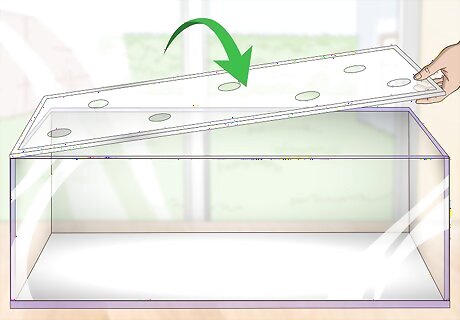
Place a secure hood on the aquarium. Oscars like to jump, and they'll even sometimes jump right out of the tank. In fact, a medium-sized Oscar can even lift the lid right off of the tank if it isn't secure enough. Choose a lid that fits tightly onto the top of your aquarium to ensure that doesn't happen. If your aquarium didn't come with a lid, write down the exact measurements of the width and depth, then visit your local aquarium supply store or pet shop.

Add a heater and a thermometer to keep the water between 74–81 °F (23–27 °C). Oscars, like most fish, are very sensitive to changes in water temperature. They're happiest when the water is around 77 °F (25 °C), but they'll tolerate a range of 74–81 °F (23–27 °C). Clip an external thermometer to the outside of the tank, then check the temperature about once a day to ensure it stays within that range. Also, run a 200W-500W heater, and adjust the settings as needed to keep the water temperature steady. If the water is too cold, it can suppress your Oscar's immune system, leaving them vulnerable to illness. If it's too warm, it can deprive the fish of oxygen, which can lead to nerve and heart damage. Oscars will often destroy a thermometer placed inside of their tank, which is why an external thermometer is recommended. Check the manufacturer's information to ensure you choose the right heater for your size tank.

Give the fish a few decorations to hide behind. Although Oscars aren't particularly shy fish, they'll be most comfortable if they have a place they can go to feel safe. Driftwood, plants, and other decor are popular options for an Oscar tank. However, Oscars spend a lot of time rearranging their environments, so don't worry about placing them in the tank perfectly. Avoid sharp or rough decoration, as they could injure the Oscar if it gets startled and darts around. Choose heavy decorations if you don't want the Oscar to move them.

Use coarse sand or gravel as a substrate. The choice of substrate is largely a matter of aesthetics. However, since Oscars produce a lot of waste, it's best to have a substrate that filters well. Gravel and sand both allow water to sift through, washing the waste out for the filter to clean up. If you do opt for sand, though, choose a coarse sand so it will be less likely to get sucked into the filter. Keep in mind that since Oscars will dig in the substrate, it's important not to use anything sharp, as this could injure the fish. If you don't want to, you don't have to include a substrate at all. Just clean the bottom of the tank occasionally, as any debris that settles will be visible.

Include a high-capacity water filter in the tank. Oscars are known for being really messy fish. They produce more waste than most fish species, and they like to rearrange their tanks, so they're constantly stirring up the bottom. While cleaning the tank is the only way to keep the water fresh, a high-quality water filter will go a long way toward reducing how often you need to clean. A water filter will help prevent the buildup of ammonia in the tank. Too much ammonia can stress the fish, causing them to lose their appetites and their color to fade. Choose a filter that is rated higher than the capacity of your tank. For instance, if you have a 75 US gal (280,000 mL) tank, you'd want at least a 100 US gal (380,000 mL) filter.
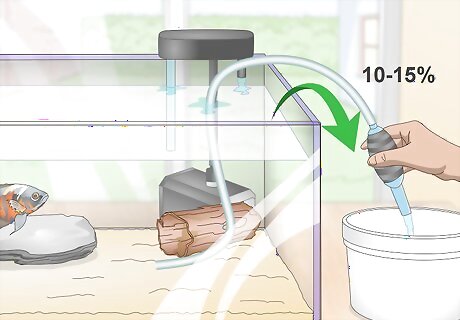
Change 10-15% of the water in your tank every week. Since Oscars are so messy, cleaning the tank is essential. The best way to keep the aquarium fresh is to take out about 10-15% of the water once a week. Then, replace that with fresh water. For example, if you have a 100 US gal (380 L) tank, you would change 10–15 US gal (38–57 L) each week. This is a gentle way to clean, since it maintains the environment that the fish are used to.

Use a water testing kit to keep the pH between 6 and 8. Most fish prefer a relatively neutral environment, and Oscars are no different. About once a week, use a test kit or pH test strips to measure the acidity of the water. If the pH is too high or too low, you'll need to remove the fish and adjust the pH. If the pH is too low, or the water is too acidic, add 1 tsp (7 g) of baking soda for every 5 US gal (19,000 mL) of water. If the pH is too high, or the water is too basic, place a clump of peat moss in a mesh bag and place it inside of the water filter. You can buy clumps of peat moss at an aquarium supply store.

Introduce tank mates from a young age or move them to a new tank. Typically Oscars do best when they're kept alone. However, if you want your Oscar to have a companion, try to introduce them as young as possible to increase the odds that they'll get along. If your Oscar is already mature, try moving the fish to a new tank when you introduce them. That way, neither one becomes territorial. You can provide 1 tank mate, or you can keep Oscars in groups of 4 or 5. However, avoid having 3 Oscars in a tank, since 2 might bond with each other and leave the other one isolated.
Feeding Your Oscars

Feed your Oscar mostly commercial cichlid pellets. About 80% of your Oscar's diet should be a commercial cichlid pellet that contains whole fish, krill, or shrimp in the ingredients list. Oscars primarily feed on small insects and crustaceans in the wild, so they need a food that's mostly made of meat. To ensure your Oscar gets all of the vitamins it needs, choose a pellet that also contains algae or green plant material. Nutritional deficiencies are the cause of the most common oscar illness, which is known as “hole in the head disease” due to the abscesses that form on the fish's head and body.
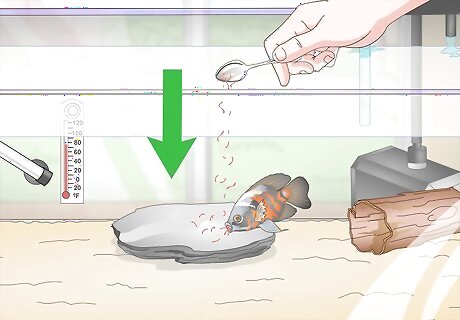
Supplement your Oscar's diet with seafood and insects. You don't necessarily have to go out and buy your Oscar fresh fish from the market, but it will be healthiest if about 20% of its food is made up of fresh, frozen, or freeze-dried food like insects, seafood, and worms. You can find these at a well-stocked fish supply store, or you can even use food that's packaged for humans! Bloodworms, feeder shrimp, krill, crickets, and mealworms are all popular options for feeding Oscars. Did You Know? Oscars aren't picky eaters—they'll eat almost anything you give them! However, you should pay close attention to their food to ensure they get a balanced diet.
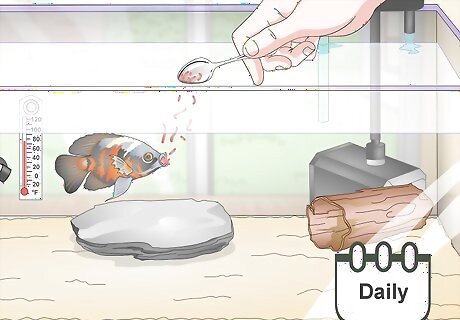
Feed adult fish about once a day. While your Oscar will eat as often as you feed it, overfeeding can lead to a dirty tank. It can even cause your fish to get sick. To prevent this, only feed your fish one time each day, and only give it as much food as it will eat in 2-3 minutes. If you're not sure how much your fish will eat, drop in a few pellets and wait for the fish to eat them, then drop in a few more. Continue this for about 3 minutes. Once you get a good idea of how much your Oscar eats at each meal, you can drop it all in at once.
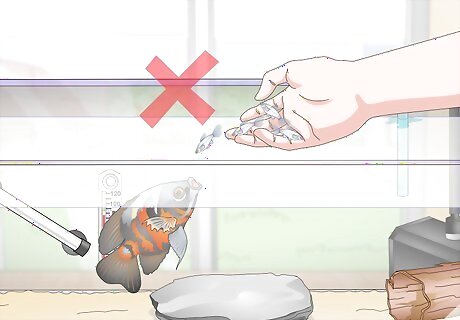
Don't give your Oscar feeder fish. Oscars will eat live prey, but that doesn't mean that giving them live fish is good for them. Feeder fish aren't nutritionally healthy for your fish, and they can sometimes spread intestinal parasites that will make your Oscar very sick. Not only do feeder fish lack the nutrition your Oscar needs, they can actually create additional problems. For instance, feeder goldfish contain high levels of an enzyme that will destroy the vitamin B1 in your Oscar's system.
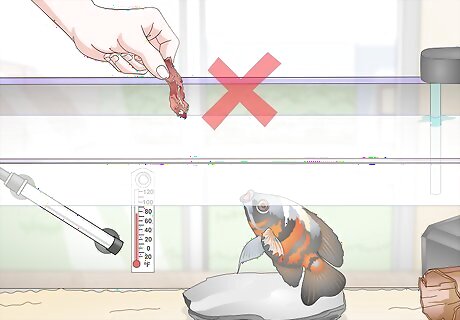
Avoid feeding animal meat to your oscar. Although Oscars are carnivorous, they shouldn't eat meat from land animals. Animal meat is very high in saturated fat, which fish can't process well. While small amounts probably won't do a lot of harm, there are much better options for food to give your Oscar.
Breeding Oscars

Purchase a breeding pair of Oscars or raise a group of juveniles together. It can be really hard to sex Oscars, so the best way to get a breeding pair is to either purchase a pair who have already successfully bred or to raise a group of Oscars together so they can pair up naturally. If you plan to raise your own breeding pair, be aware that it will probably take about 2 years for them to fully mature. Females have a cone-shaped tube near their anal fin, known as the egg tube. However, this stays retracted most of the time. Males have a thin spike, which they use to fertilize the eggs.

Change 20-30% of the water when you're ready for the fish to breed. In the wild, Oscars breed during the rainy season. However, they sometimes need help when they live in captivity. By changing more water than normal, you can help signal to the Oscars that breeding season is coming up. Do this at the same time as your normal weekly cleaning to avoid changing too much of the water at once, since you don't want to stress the fish.

Lower the temperature in the tank by 3-4°F (2°C). The rainy season in the wild typically corresponds with cooler temperatures. To replicate this effect, lower the temperature on your heater slightly. Don't drop the temperature any more than this, or you could shock your fish.
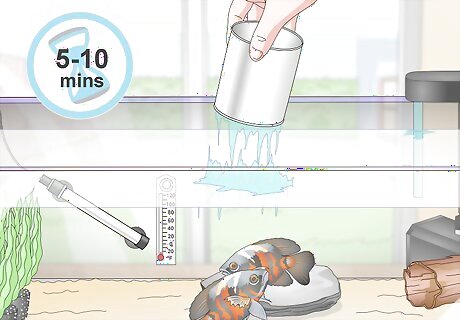
Sprinkle water on top of the tank for 5-10 minutes a day. If you really want to encourage your fish to breed, spend a few minutes a day recreating rainfall on top of the fish tank. You can either use a watering can to create rain by hand, or you can install a spray bar just above the water, and let it run for a few minutes once a day. You can find spray bars wherever aquarium equipment is sold.

Watch the fish for breeding rituals. Sometimes, Oscar breeding can look aggressive. Your fish may slap tails, chase each other around the tank, or lock mouths with each other. However, these are actually signs that your fish are breeding, and you're likely to see eggs soon. You may even be able to see the female laying eggs across the bottom of the tank!
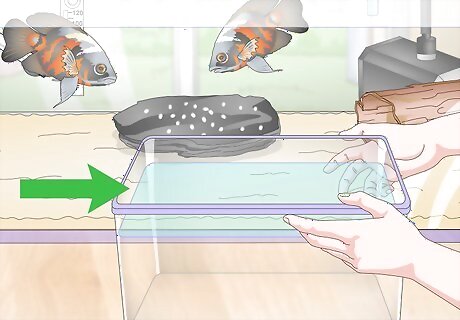
Set up a fry nursery once you see eggs. A female Oscar can lay up to 1000 eggs at a time, although this number is often much lower than that. Once you see the eggs, start preparing a separate tank, because the eggs only take about 3 days to hatch. Use water from the parent tank so you don't shock the fry when you move them. Don't be alarmed if you see the pair eating some of the eggs. They do this to remove deformed or unhealthy eggs from the batch. Right before the eggs hatch, you may see them shaking slightly as the fry try to break free.
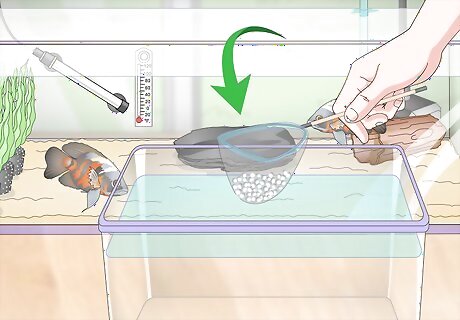
Move newly-hatched fry to their own tank. Once the fry are hatched, the parents will sometimes eat them. To avoid this, gently scoop the fry up with a net and move them to their separate tank as soon as possible after they hatch. Caution: The parents may try to protect their eggs, so watch your fingers!

Feed the fry baby brine shrimp after they're 4 days old. The fry will still have a yolk sac hanging when they hatch. This typically stays for about 4 days, and it will feed them during this time. After the yolk sacs disappear, you can give the fry baby brine shrimp about 3 times a day. Give them a small pinch of the shrimp, and if they eat all the food within 2 minutes, you can give them a little more. Continue this until the fry reach 1–2 in (2.5–5.1 cm) long. Remove any uneaten food from the nursery before you feed the fry again. Once the fish reach about 1–2 in (2.5–5.1 cm) long, they're ready to find a new home!


















Comments
0 comment